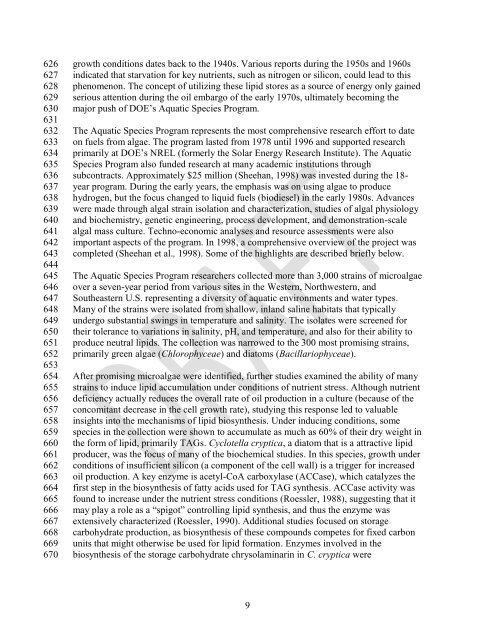Download the Algal Biofuels Roadmap draft document - Sandia
Download the Algal Biofuels Roadmap draft document - Sandia
Download the Algal Biofuels Roadmap draft document - Sandia
Create successful ePaper yourself
Turn your PDF publications into a flip-book with our unique Google optimized e-Paper software.
626<br />
627<br />
628<br />
629<br />
630<br />
631<br />
632<br />
633<br />
634<br />
635<br />
636<br />
637<br />
638<br />
639<br />
640<br />
641<br />
642<br />
643<br />
644<br />
645<br />
646<br />
647<br />
648<br />
649<br />
650<br />
651<br />
652<br />
653<br />
654<br />
655<br />
656<br />
657<br />
658<br />
659<br />
660<br />
661<br />
662<br />
663<br />
664<br />
665<br />
666<br />
667<br />
668<br />
669<br />
670<br />
growth conditions dates back to <strong>the</strong> 1940s. Various reports during <strong>the</strong> 1950s and 1960s<br />
indicated that starvation for key nutrients, such as nitrogen or silicon, could lead to this<br />
phenomenon. The concept of utilizing <strong>the</strong>se lipid stores as a source of energy only gained<br />
serious attention during <strong>the</strong> oil embargo of <strong>the</strong> early 1970s, ultimately becoming <strong>the</strong><br />
major push of DOE‘s Aquatic Species Program.<br />
The Aquatic Species Program represents <strong>the</strong> most comprehensive research effort to date<br />
on fuels from algae. The program lasted from 1978 until 1996 and supported research<br />
primarily at DOE‘s NREL (formerly <strong>the</strong> Solar Energy Research Institute). The Aquatic<br />
Species Program also funded research at many academic institutions through<br />
subcontracts. Approximately $25 million (Sheehan, 1998) was invested during <strong>the</strong> 18year<br />
program. During <strong>the</strong> early years, <strong>the</strong> emphasis was on using algae to produce<br />
hydrogen, but <strong>the</strong> focus changed to liquid fuels (biodiesel) in <strong>the</strong> early 1980s. Advances<br />
were made through algal strain isolation and characterization, studies of algal physiology<br />
and biochemistry, genetic engineering, process development, and demonstration-scale<br />
algal mass culture. Techno-economic analyses and resource assessments were also<br />
important aspects of <strong>the</strong> program. In 1998, a comprehensive overview of <strong>the</strong> project was<br />
completed (Sheehan et al., 1998). Some of <strong>the</strong> highlights are described briefly below.<br />
The Aquatic Species Program researchers collected more than 3,000 strains of microalgae<br />
over a seven-year period from various sites in <strong>the</strong> Western, Northwestern, and<br />
Sou<strong>the</strong>astern U.S. representing a diversity of aquatic environments and water types.<br />
Many of <strong>the</strong> strains were isolated from shallow, inland saline habitats that typically<br />
undergo substantial swings in temperature and salinity. The isolates were screened for<br />
<strong>the</strong>ir tolerance to variations in salinity, pH, and temperature, and also for <strong>the</strong>ir ability to<br />
produce neutral lipids. The collection was narrowed to <strong>the</strong> 300 most promising strains,<br />
primarily green algae (Chlorophyceae) and diatoms (Bacillariophyceae).<br />
After promising microalgae were identified, fur<strong>the</strong>r studies examined <strong>the</strong> ability of many<br />
strains to induce lipid accumulation under conditions of nutrient stress. Although nutrient<br />
deficiency actually reduces <strong>the</strong> overall rate of oil production in a culture (because of <strong>the</strong><br />
concomitant decrease in <strong>the</strong> cell growth rate), studying this response led to valuable<br />
insights into <strong>the</strong> mechanisms of lipid biosyn<strong>the</strong>sis. Under inducing conditions, some<br />
species in <strong>the</strong> collection were shown to accumulate as much as 60% of <strong>the</strong>ir dry weight in<br />
<strong>the</strong> form of lipid, primarily TAGs. Cyclotella cryptica, a diatom that is a attractive lipid<br />
producer, was <strong>the</strong> focus of many of <strong>the</strong> biochemical studies. In this species, growth under<br />
conditions of insufficient silicon (a component of <strong>the</strong> cell wall) is a trigger for increased<br />
oil production. A key enzyme is acetyl-CoA carboxylase (ACCase), which catalyzes <strong>the</strong><br />
first step in <strong>the</strong> biosyn<strong>the</strong>sis of fatty acids used for TAG syn<strong>the</strong>sis. ACCase activity was<br />
found to increase under <strong>the</strong> nutrient stress conditions (Roessler, 1988), suggesting that it<br />
may play a role as a ―spigot‖ controlling lipid syn<strong>the</strong>sis, and thus <strong>the</strong> enzyme was<br />
extensively characterized (Roessler, 1990). Additional studies focused on storage<br />
carbohydrate production, as biosyn<strong>the</strong>sis of <strong>the</strong>se compounds competes for fixed carbon<br />
units that might o<strong>the</strong>rwise be used for lipid formation. Enzymes involved in <strong>the</strong><br />
biosyn<strong>the</strong>sis of <strong>the</strong> storage carbohydrate chrysolaminarin in C. cryptica were<br />
9


